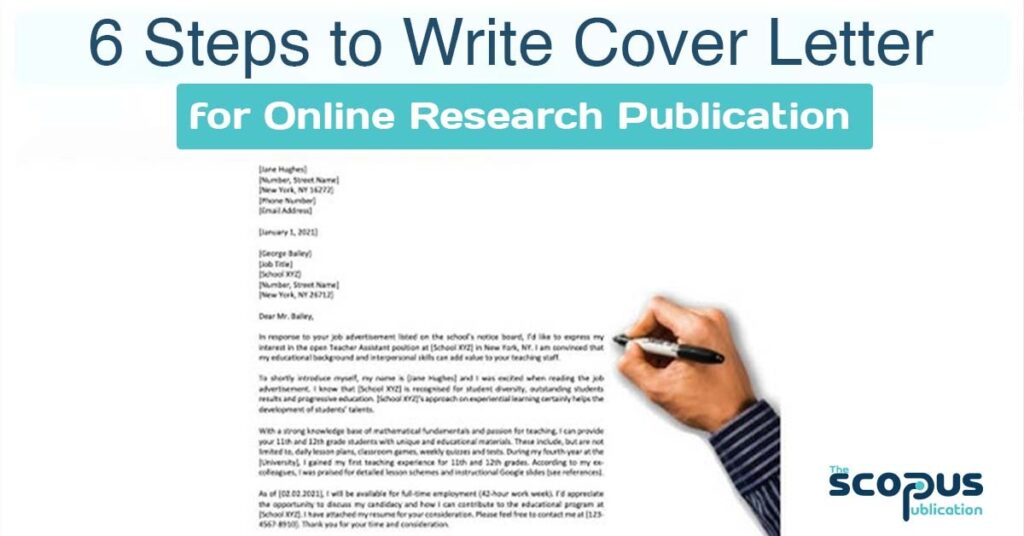You have done an incredible job with your research work that deserves reach and recognition. Now, you want a home for your research paper where it can shine and make its mark. Writing a cover letter is an essential part to find your research paper its well-deserved home at an online research publication.
You will approach this step after selecting a journal for research publication and completing the writing and editing of your paper. Here is the whole process to embark on this step and make it a success.
Purpose of Writing a Research Paper
Before we detail the process of writing a cover letter, let’s understand the purpose it serves in getting your research published. Cover letters give a brief introduction of your work to the reader. In the case of journal submission, your cover letter will communicate the reason and need for the research work you have conducted.
In essence, its purpose is to sell the research paper to the journal editor and prompt them to give the paper a chance. Considering this purpose, you should highlight the impact of your research in this letter. While you should use a professional tone, don’t forget the element of persuasion. Structure the letter to give more emphasis to the positives of the research including noteworthy findings or out-of-the-box methodology.
Process of Writing a Cover Letter
Here is how you should write your cover letter.
Gather All the Details
Yes, it’s the basic step that you don’t see yourself missing. Still, many authors prolong their writing process just because they don’t define certain attributes before starting to write. At other times, they may define it but fail to refer to the original document or miss details because the document wasn’t kept handy at the time of writing the cover letter.
You will need a clear understanding of your research project, its purpose, title, and scope. Also you need to note the major findings that prove a point that is being discussed in the industry at the time. You may want to convey complete information to your publication support services provider if you have asked them to assist in writing your cover letter.
Pay Attention to Format
You will want your cover letter to appear professional. One way to do this is to format it properly. Pay attention to the formatting guidelines offered by the journal you are submitting to. If you cannot find these guidelines, use a standard letter format. You will need to avoid indentation, use single spacing between lines, and right-side justification of the text.
Be professional and polite in greetings. Knowing the editor’s name and including it in the letter are standard practices. Make it more professional by using their professional titles along with their names. You will also use the same name format in addressing the letter at its top.
Introduce Your Research
Immediately after these formalities, you will want to get straight to your research. The first paragraph of your cover letter should talk about your research. Use this paragraph to define its purpose and impact. Here, is your chance to make an impression on the editor with key details that might interest them.
Note that in a cover letter, brevity is your friend. You don’t want to lose words on insignificant information. If you don’t do well in persuasive writing, don’t fret. Instead, ask for help from research publication support services. They will help you with writing an effective cover letter that will encourage the editor to review your paper.
Explain Why Your Research Is a Good Fit for the Journal
After you have detailed the research premise and scope, you need to focus on its relevance to the journal. You must have worked on this detail till now. Truth be told, finding a match between the research and its target journal is a step that’s carried out when authors seek relevant journals.
At the stage of writing the cover letter, you must retrieve the work you did to define the purpose and readership of your research. Use the benefits it will create for its audiences to inspire this part of the cover letter. If your work is a continuation of a recently published research, you should also mention that in this section.
Here, your purpose is to make your research interesting to the editor. You can create interest by including a major finding your research has uncovered that may attract the editor’s attention.
Detail Conflict of Interests
It’s a wise and professional move to state any conflict of interest associated with the research. Be clear but brief in presenting these conflicts. If it doesn’t entertain any such conflict, claim as such.
You may also want to address the fact that your research isn’t submitted to any other online research publication at the time of its submission to the addressed journal.
Close with Contact Information
After thanking the editor, you will want to close your letter. At the end, you must present the contact information of the authors and co-authors of the research. This information must contain the name and email address of the researchers. Include the name of your institute to add credibility and to give credit to the research department.
Wrapping Up
Writing your cover letter is an essential step in submitting your research paper to a research journal. You must do it professionally and be truthful and upfront. The most important section in this letter is finding and expressing the relevance and potential of your work in the scope of the target journal. You must be clear and confident of the influence your research can have on that particular field of science. Top off your confidence and dedication to your research with the major breakthroughs your research has made. Mention the most important findings of your work in the cover letter to encourage the editor to read the whole paper and continue the review procedure. If you find writing this letter hard, hire professional research paper publishing services to do that for you.


